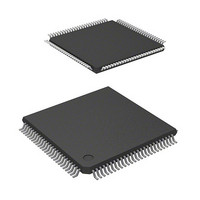HD6417020SVX12I Renesas Electronics America, HD6417020SVX12I Datasheet - Page 178

HD6417020SVX12I
Manufacturer Part Number
HD6417020SVX12I
Description
IC SUPERH MPU ROMLESS 100TQFP
Manufacturer
Renesas Electronics America
Series
SuperH® SH7020r
Datasheet
1.HD6417020SVX12IV.pdf
(511 pages)
Specifications of HD6417020SVX12I
Core Processor
SH-1
Core Size
32-Bit
Speed
12.5MHz
Connectivity
EBI/EMI, SCI
Peripherals
DMA, POR, PWM, WDT
Number Of I /o
32
Program Memory Type
ROMless
Ram Size
1K x 8
Voltage - Supply (vcc/vdd)
3 V ~ 5.5 V
Oscillator Type
Internal
Operating Temperature
-40°C ~ 85°C
Package / Case
100-TQFP, 100-VQFP
Lead Free Status / RoHS Status
Contains lead / RoHS non-compliant
Eeprom Size
-
Program Memory Size
-
Data Converters
-
Available stocks
Company
Part Number
Manufacturer
Quantity
Price
Part Number:
HD6417020SVX12I
Manufacturer:
HITACHI/日立
Quantity:
20 000
Company:
Part Number:
HD6417020SVX12IV
Manufacturer:
RENESAS
Quantity:
63
Company:
Part Number:
HD6417020SVX12IV
Manufacturer:
Renesas Electronics America
Quantity:
10 000
- Current page: 178 of 511
- Download datasheet (2Mb)
8.10.1
This LSI has the bus arbitration function which can give bus ownership to an external device when
the device requests the bus ownership. When BREQ is input and the bus cycle being executed by
the CPU or DMAC is completed, BACK becomes low and a bus is released for an external device.
At this time, the following operates when bus arbitration conflicts with refresh.
1. If DRAM refresh is requested in this LSI when a bus is released and BACK is low, BACK
2. When BREQ changes from high to low and internal refresh is requested at the timing of the
158 RENESAS
becomes high and the occurrence of the refresh request can be informed externally. At this
time, the external device may generate a bus cycle when BREQ is low even if BACK is high.
Therefore, a bus remains released to the external device. Then, when BREQ becomes high, this
LSI gets bus ownership, and executes refresh and the bus cycle of the CPU or DMAC. After
the external device gets bus ownership and BACK is low, refresh is requested when BACK
becomes high even if the low level of BREQ is input. Therefore, turn BREQ high immediately
to release a bus for this LSI to hold DRAM data (See figure 8.36).
bus release of this LSI, BACK may remain high (do not become low). A bus is released to the
external device since the low level of BREQ is input. This operation is based on the above
specification (1). To hold DRAM data, turn BREQ high and release a bus to this LSI
immediately when the external device detects that BACK does not change to low during a
fixed time this LSI (See figure 8.37). When a refresh request is generated and BACK returns
to high, as shown in figure 8.37, a momentary narrow pulse-shaped spike may be output where
BACK was originally supposed to become low.
The Operation of Bus Arbitration
Address, data, strobe pin:
Bus release response
High-level output
BREQ received
High impedance
Bus released
Strobe pin:
SuperH
Figure 8.35 Bus Release Procedure
BACK = low
BREQ = low
BACK
Bus acquisition
External device
Bus request
acknowledge
Related parts for HD6417020SVX12I
Image
Part Number
Description
Manufacturer
Datasheet
Request
R

Part Number:
Description:
KIT STARTER FOR M16C/29
Manufacturer:
Renesas Electronics America
Datasheet:

Part Number:
Description:
KIT STARTER FOR R8C/2D
Manufacturer:
Renesas Electronics America
Datasheet:

Part Number:
Description:
R0K33062P STARTER KIT
Manufacturer:
Renesas Electronics America
Datasheet:

Part Number:
Description:
KIT STARTER FOR R8C/23 E8A
Manufacturer:
Renesas Electronics America
Datasheet:

Part Number:
Description:
KIT STARTER FOR R8C/25
Manufacturer:
Renesas Electronics America
Datasheet:

Part Number:
Description:
KIT STARTER H8S2456 SHARPE DSPLY
Manufacturer:
Renesas Electronics America
Datasheet:

Part Number:
Description:
KIT STARTER FOR R8C38C
Manufacturer:
Renesas Electronics America
Datasheet:

Part Number:
Description:
KIT STARTER FOR R8C35C
Manufacturer:
Renesas Electronics America
Datasheet:

Part Number:
Description:
KIT STARTER FOR R8CL3AC+LCD APPS
Manufacturer:
Renesas Electronics America
Datasheet:

Part Number:
Description:
KIT STARTER FOR RX610
Manufacturer:
Renesas Electronics America
Datasheet:

Part Number:
Description:
KIT STARTER FOR R32C/118
Manufacturer:
Renesas Electronics America
Datasheet:

Part Number:
Description:
KIT DEV RSK-R8C/26-29
Manufacturer:
Renesas Electronics America
Datasheet:

Part Number:
Description:
KIT STARTER FOR SH7124
Manufacturer:
Renesas Electronics America
Datasheet:

Part Number:
Description:
KIT STARTER FOR H8SX/1622
Manufacturer:
Renesas Electronics America
Datasheet:

Part Number:
Description:
KIT DEV FOR SH7203
Manufacturer:
Renesas Electronics America
Datasheet:











